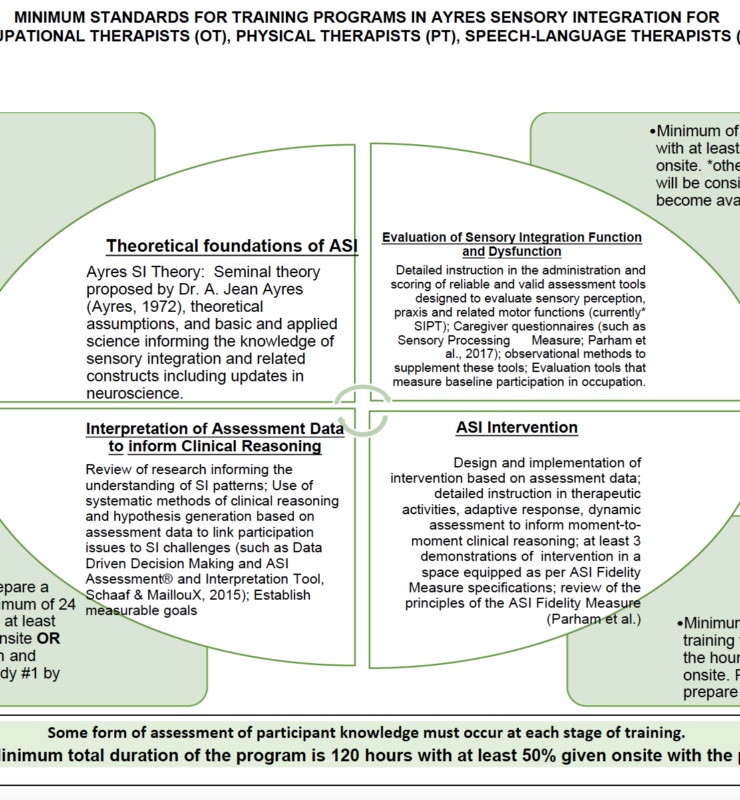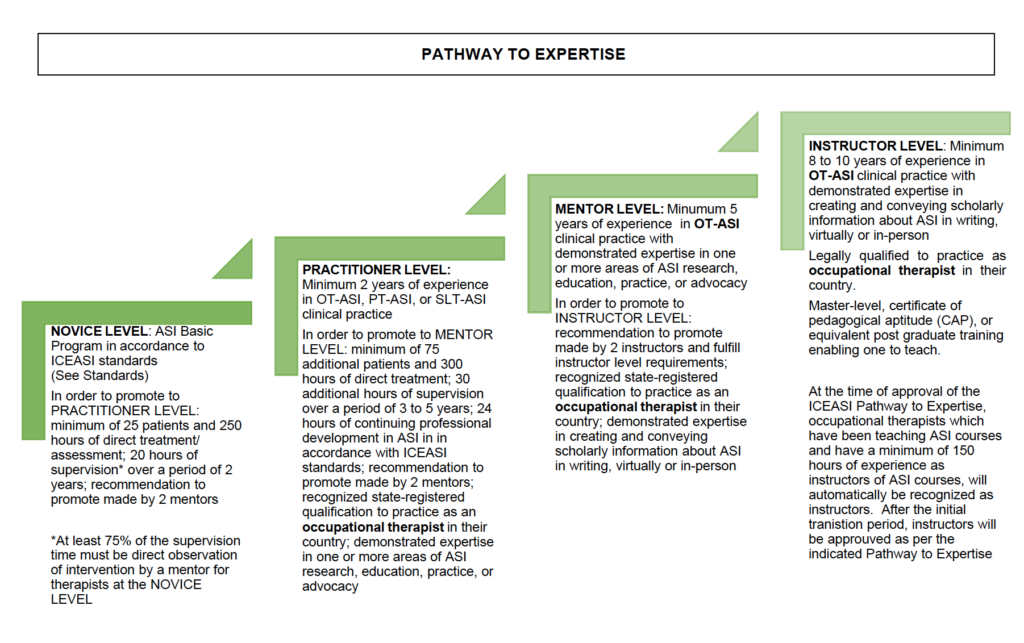As the number of people doing the ASI WIse CLASI Certification in Ayres Sensory Integration is growing, we are increasingly being asked and messaged about equivalencies.
“On the child’s statement, it requests SI Network level 3. I’m sorry as I know we spoke about this previously and there isn’t a direct comparison as such. How does this work?
Therapy Manager
Please refer people to ICEASI and their Education Standards. ICEASI was set up to help provide clear guidance and support to those developing programmes and certification in Ayres’ Sensory Integration. ICEASI membership is different to ICEASI programme accreditation. It is important to note that ICEASI is not a regulatory body and membership is voluntary.
At ASI Wise, we cannot comment on other programmes on which we have not taught. It will therefore be important for individuals and organisations asking this question to think about what is included in each ASI certification programme and consider how and if a programme meets the standards and what the equivalencies are. ICEASI are always happy to answer any questions via email. Their contact details are available on their website: www.iceasi.org.
In the old days, in the UK and Ireland, this was easier. The old programme, on which our ASI Wise lecturers and world experts (who have always supported the development of ASI programmes in the UK and Ireland) taught, in-classroom courses were divided neatly into neuroscience, assessment & clinical reasoning and intervention. Before, the SI Network Programme, on which our lecturers all originally taught, was the only choice of programme by one provider for therapists in the UK and Ireland. However it is important to note that what was SI3 in 2005, was also different to the SI2/3 taught from 2011 to 2017. Now, having left SI Network, ASI Wise has also developed an offer that meets the ICEASI standards, and we teach this the ASI Wise CLASI CASI programme, with the same world experts alongside whom we have always taught. This would therefore be our guidance and advice. So now, this question posed above, is a tricky question to answer.
The ICEASI Education standards include a framework, upon which programme providers can develop their training, which may exceed the basic standards. This exceeding of the standards would not prohibit a programme for applying for accreditation. For training programmes to be accredited, the programme should include definite features that means it aligns to the research and evidence base developed by Ayres and many others since. This is the research that is now increasingly providing support for the efficacy of Ayres’ Sensory Integration. Please refer to the ICEASI Education Standards to consider the skills a therapist has when they have achieved training at the different levels, and how these levels equate to different programmes.
ICEASI has a process to recognise programmes that do and to be able to credit these programmes. At the last ICEASI meeting the accreditation logo ideas were launched for consideration, so in the coming months, the agreed logo will start to be used. This will be helpful.
The emerging use of technology to enhance programmes and reduce travel costs, using technology to teach what can be taught online as preparation and teaching live face to face what requires interactive learning and discussion makes these comparisons harder. And COVID-19 has complicated this a little more in the short term, as we have had to find ways to creative replicate the interactive learning benefits of teaching face to face, using technology like Zoom.
We would respectfully suggest that the ASI Wise CLASI CASI programme, provided with leadership from published researchers and experts in the field, more than equips certified therapists to practice ASI across the life-span. We recommend that therapist receive ongoing mentoring and supervision to do this and that in practices and hospitals where therapists are learning ASI, supervision structures and mentoring will support therapists practising while undertaking their training to be able to offer increasingly more skilled assessment and intervention, with support and guidance from more senior and therapists with certification in ASI.
Each programme and even different programmes in the same country may all meet the standards but in different ways. ICEASI does not prescribe what cannot be taught, though it does specify the minimum.
An example of this might be that in the UK ASI Wise lecturers have led and developed on the work of Lorna Jean King, Winnie Dunn, Diana Henry, Teresa May-Benson and Vivyan Alers in the application of ASI with older teens, adults and older adults. We have created and adapted tools and methods to assess and intervene for the clients beyond childhood, including how the SIPT is interpreted and in future how we might adapt and use the EASI with teens and adults. Initially, we did this before any tools existed to assess and provide therapy to those who were older, including for those in restricted environments and those unable to mobilise across paediatric equipment. In the past, many swing systems were not built to accommodate adult frames. We have added new tools and equipment into our teaching as this area, expanding on the body of knowledge and application in practice beyond childhood, in which we are considered experts. The Sensory Ladder, Sensory Choices Checklist, ASI adapted DBT Handbook, ASI Chain Analysis, and use of gym equipment and the natural environment are our contributions to the development of the application in practice. WE have brought these developments with us to ASI Wise from our SI Network days and continued to develop and deliver these within the teaching programme we now offer here in the UK with its unique focus on sensory integration across the span. The addition of this learning and these tools/equipment to the programme for those working beyond childhood has not precluded the ASI Wise programme from meeting the ICEASI standards as part of the CLASI Certification in ASI programme offered in the UK and Ireland.

